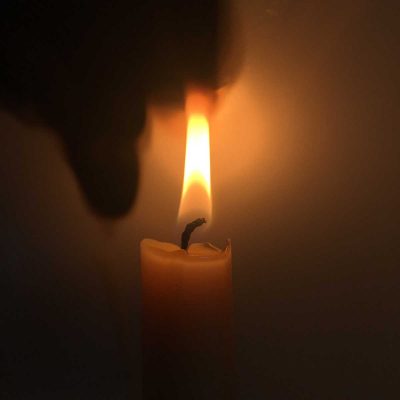
Soot of beeswax Figures 4a, 4b, 4c / Quote 1 & Recipe 1 / Reconstruction 1
Collecting soot from beeswax candles for preparation of black pigment is advised by the anonymous, late fourteenth-century author of De Arte Illuminandi[1]. While it is probably easily available to the modern reader, wax from bees was a precious product during the middle ages. Cera vergine, beeswax, was a relatively scarce product in Europe, centuries-long reserved for church and court.[2] Apiculture was not yet broadly established and limited to monastic and local bee-keepers. They could not cope with the rather extensive consumption of candles for liturgical and representative purposes, since one bee hive only produces about 0.6kg of beeswax annually.[3] In central Europe, beeswax was an imported product, traded from Russia through the Hanseatic League, and from countries around the Black Sea, the Balkans and North Africa via Italian and Spanish merchants, who shipped it to the harbors of Bruges, amongst other destinations.[4] It was a display of wealth and power of the citizens of Bruges, that beeswax-candle bearers always preceded the procession when the Duke of Burgundy entered or left their city.[5] Beeswax was not only used for candles, but also for wax seals and for bronze casting.
“Fumus est color niger, si cum ab igne candele sepi vel cere, vel a lampadis lumine exit, colligatur, qui aliter fuscus, et aliter fuligo nominatur.”[1]
[1] “Fumus [smoke] is a black color when it is collected as soon as it emerges from the fire of a tallow or wax candle, or from the flame of a lamp, and which is sometimes called fuscus, sometimes fuligo.” In: Le Begue. 1431. BnF MS Latin 6741: fol. 6v, table of synonyms. Transcribed in: In: Merrifield. 1849. Original Treatises, Dating from the XIIth to the XVIIIth Centuries, Vol. 1: p. 27, Translated by I. Bartusch, Heidelberger Akademie der Wissenschaften.

It was available via local sellers. Bees-wax was regularly purchased for artistic purposes by the Burgundian court. The ducal records are a rich source of information regarding trade of artists’ materials, including beeswax, in the Burgundian dukedom. In 1385 for instance, four pounds of wax were acquired from Guiot Poissonnier, espicier in Dijon, for artistic purposes.[6] With a modal price of 48 deniers per pound, wax was much cheaper than the most precious pigment, ultramarine (30720 deniers/pound), the expensive vermillion (160 deniers/pound), and even cheaper than a good-quality lead white (80 deniers/pound). [7] One record is especially interesting, since it tells of the purpose of the purchase: in April 1399, 10 pounds of wax candles were bought from Perrenot Berbisey, a merchant in Dijon. They were designated for the court painter Jean Malouel, then also situated in Dijon, to allow him to work by night.[8] Obviously, beeswax was available to artists in Valois Burgundy, and even for non-clerical applications.
Besides allowing nocturnal artistic work, beeswax might indeed have served as a source for obtaining smaller quantities of black pigment, especially in the monastic scriptoria, which had their own beekeeping. Le Begue (1431) distinguishes the soot of candles from wax and tallow under the lemma Fumus as quoted. Producing soot from beeswax candles is associated with some unexpected challenges that only become apparent during reconstruction.
[1] De Arte Illuminandi, National Library Napoli, HS 1II.E.27. 1350-1400. In: Brunello. 1992. De Arte Illuminandi: p. 46-47.
[2] Büll. 1977. Das Große Buch Vom Wachs. Band 1: p. 157ff.
[3] Stuetzel. 2013. Wachs als Rohstoff, Produkt und Handelsware. PhD Thesis: p. 14.
[4] See Stuetzel. 2013: p. 32.
[5] See Stuetzel. 2013: p. 21, endnotes 151, 152.
[6] Nash. 2010. The Supply, Aquisition, Cost and Employment of Painters’ Materials at the Burgundian Court, c. 1375-1419: p. 103, tab. 1 ‘Payments for painters materials in the general, regional and local accounts for Burgundy, 1375-1416, Dijon’, 28.12.1385: wax.
[7] See Nash: p. 173-174, tab. 26 ‘Comparative prices for painters materials’.
[8] See Nash: p. 121, tab. 2 ‘Payments for painters’ materials in the Champmol accounts 1387-1404, Dijon’, 1.4.1399: wax candles.
[1] De Arte Illuminandi, National Library Napoli, HS 1II.E.27. 1350-1400. In: Brunello. 1992. De Arte Illuminandi: p. 46-47.
[2] Büll. 1977. Das Große Buch Vom Wachs. Band 1: p. 157ff.
[2] Büll. 1977. Das Große Buch Vom Wachs. Band 1: p. 157ff.
[4] See Stuetzel. 2013: p. 32.
[4] See Stuetzel. 2013: p. 32.
[4] See Stuetzel. 2013: p. 32.
[7] See Nash: p. 173-174, tab. 26 ‘Comparative prices for painters materials’.
[8] See Nash: p. 121, tab. 2 ‘Payments for painters’ materials in the Champmol accounts 1387-1404, Dijon’, 1.4.1399: wax candles.